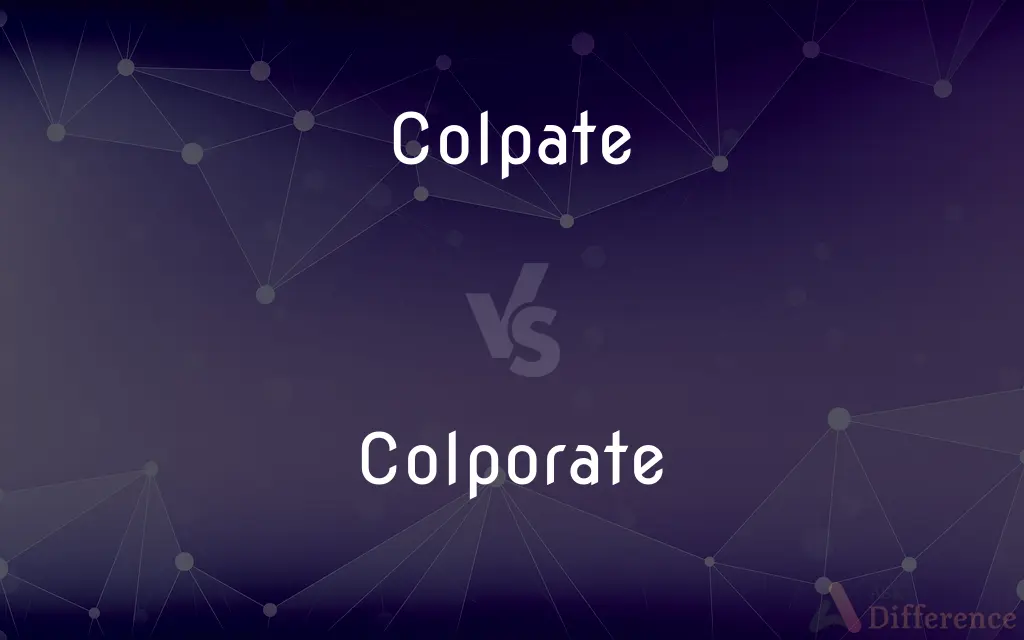Colpate vs. Colporate — What's the Difference?
Edited by Tayyaba Rehman — By Maham Liaqat — Updated on April 25, 2024
Colpate pollen grains have one or more elongated furrows or pores, aiding germination, whereas colporate pollen features both furrows and additional pore-like structures enhancing its flexibility and viability.

Difference Between Colpate and Colporate
Table of Contents
ADVERTISEMENT
Key Differences
Colpate pollen grains are characterized by one or more longitudinal furrows that serve as germination sites. Whereas colporate pollen not only features these furrows but also includes additional pore-like structures at the ends or along these furrows, which can enhance the flexibility and viability of the pollen grain.
In terms of structure, colpate pollen grains are simpler with their straightforward furrows that stretch longitudinally across the pollen exterior. On the other hand, colporate pollen grains have a more complex morphology that combines these furrows with overlaying pores, providing multiple pathways for pollen tube emergence.
The ecological function of colpate pollen primarily involves straightforward germination, focusing on the efficiency of breaking through the pollen wall. In contrast, colporate pollen's additional pores provide a structural advantage, allowing the pollen to adapt to more varied environmental conditions and promoting higher germination rates under stress.
In botanical classification, colpate pollen is often observed in more specific plant families, indicating a more specialized evolutionary path. Whereas colporate pollen, with its dual structures, is found across a broader range of plant families, suggesting a versatile adaptation to diverse ecological niches.
The difference in germination potential is notable, with colpate pollen typically showing straightforward germination behavior. Whereas colporate pollen, due to its complex openings, often exhibits enhanced germination capabilities, making it more effective in various climatic conditions.
ADVERTISEMENT
Comparison Chart
Structure
Furrows only
Furrows combined with pores
Complexity
Less complex
More complex
Germination Site
Longitudinal furrows
Furrows and additional pores
Ecological Role
Simple germination processes
Enhanced adaptability and viability
Plant Families
More limited, specific families
Wider range, diverse families
Compare with Definitions
Colpate
Characteristic of simpler pollen grain structure.
Biologists appreciate colpate pollen for its straightforward germination mechanics.
Colporate
Indicates a complex and adaptable pollen structure.
Due to its colporate structure, the pollen adapts well across various environments.
Colpate
Pollen with one or more longitudinal furrows.
The microscope revealed the pollen was colpate, with several distinct furrows.
Colporate
More effective in variable climatic conditions.
Colporate pollen thrives due to its enhanced structural resilience.
Colpate
Aids in the direct germination process.
The colpate structure facilitates easy pollen tube emergence.
Colporate
Enhances pollen tube emergence under stress.
The colporate features facilitate germination even in challenging conditions.
Colpate
Less adaptable to environmental variations.
Colpate pollen is less resistant to ecological stress compared to more complex forms.
Colporate
Pollen with furrows and overlaying pores.
The colporate pollen's additional pores make it more viable in harsh climates.
Colpate
Found in specific types of flowering plants.
The botanist identified the plant as belonging to a family known for colpate pollen.
Colporate
Common in diverse plant families.
Colporate pollen is a hallmark of evolutionary adaptability in many angiosperms.
Colpate
Having one or more colpi, or grooves, on each pollen grain.
Colporate
Having colpi
Common Curiosities
In what types of plants are colpate and colporate pollen found?
Colpate pollen is typically found in more specialized plant families, whereas colporate pollen appears in a broader range of families.
Can the type of pollen affect plant reproduction success?
Yes, the structural characteristics of pollen, such as being colpate or colporate, can significantly influence the success of plant reproduction, particularly under varying environmental conditions.
Which type of pollen is better adapted to environmental stress?
Colporate pollen, with its additional pores, is generally better adapted to handle environmental stress than colpate pollen.
Why do some plants have colpate pollen and others colporate?
Plants evolve pollen structures like colpate and colporate to adapt to their specific pollination mechanisms and environmental challenges, with colporate often being more adaptable to varied conditions.
What is the main structural difference between colpate and colporate pollen?
Colpate pollen has only furrows, while colporate pollen includes both furrows and pores.
Does the complexity of colporate pollen affect its dispersal ability?
Yes, the added structural features of colporate pollen can aid in better dispersal capabilities, especially in wind or animal-assisted pollination scenarios, due to its potentially greater resilience and adaptability.
How do the structures of colpate and colporate pollen affect their germination?
Colpate pollen has a straightforward germination process, while colporate pollen's additional pores allow for more versatile and resilient germination.
How does the presence of pores in colporate pollen benefit the plant?
The pores in colporate pollen enhance flexibility and surface area for germination, potentially increasing the pollen's effectiveness in fertilization under diverse environmental situations.
Is there a visual difference between colpate and colporate pollen when viewed under a microscope?
Yes, colpate pollen will display clear, longitudinal furrows, whereas colporate pollen will also show additional pore-like structures superimposed on or near the furrows.
What methods are used to study the differences between colpate and colporate pollen?
Techniques include microscopy, especially electron microscopy, which provides detailed images of pollen architecture, and genetic studies that link pollen structure to specific genes and evolutionary adaptations.
What role does pollen morphology play in determining plant family?
Pollen morphology, including whether it is colpate or colporate, is critical in plant taxonomy and helps scientists classify plants into families and understand evolutionary relationships.
Are there any specific climatic conditions that favor the formation of colporate pollen?
Colporate pollen is generally favored in environments where plants face significant ecological stresses, such as variable climates, as its structural complexity provides greater resilience.
What impact does the pollen type have on the evolution of a plant species?
Pollen types like colpate and colporate can influence the evolutionary trajectory of plant species by affecting their reproductive success and adaptability to new or changing environments.
Can colpate pollen evolve into colporate pollen?
Evolutionary transitions from simpler colpate to more complex colporate pollen are possible and have been documented, often as a response to ecological pressures that favor increased adaptability.
How do botanists and palynologists use knowledge about pollen types like colpate and colporate?
Botanists and palynologists study these pollen types to understand plant evolution, classification, and ecological relationships, as well as to reconstruct past climates and environments.
Share Your Discovery

Previous Comparison
Constantly vs. Consistently
Next Comparison
Contemner vs. ContemnorAuthor Spotlight
Written by
Maham LiaqatEdited by
Tayyaba RehmanTayyaba Rehman is a distinguished writer, currently serving as a primary contributor to askdifference.com. As a researcher in semantics and etymology, Tayyaba's passion for the complexity of languages and their distinctions has found a perfect home on the platform. Tayyaba delves into the intricacies of language, distinguishing between commonly confused words and phrases, thereby providing clarity for readers worldwide.














































